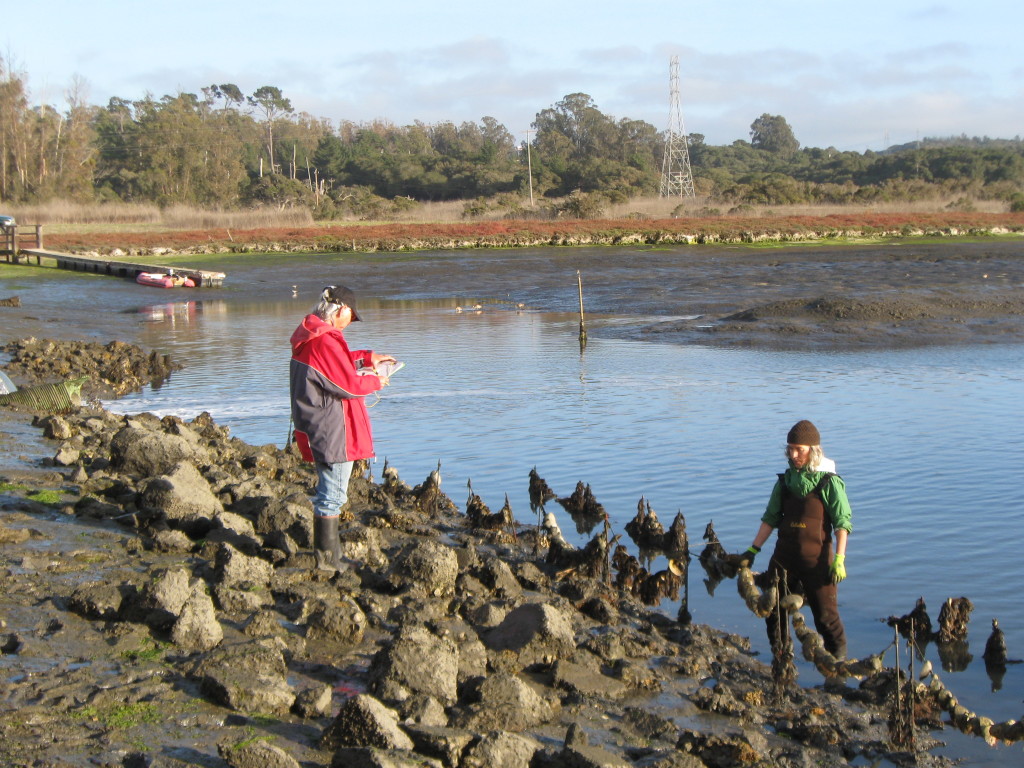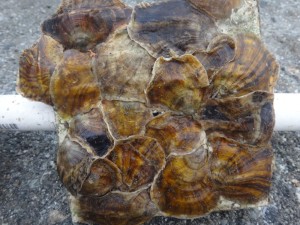
Olympia oysters (Matthew Gray/Oregon State University)
by Kristen Minogue
Act local. Diversity pays. Those two phrases could hold the key to saving young Olympia oysters, the only native oysters on the West Coast of North America. What they need are large networks of adult oyster beds to settle on—and a diverse “environmental portfolio,” finds a new study in Ecology.
Olympia oysters are filter feeders that can help purify the water, and their shells can provide habitat for a vast array of aquatic life. But they’ve endured a series of setbacks since the boom that gave birth to present-day San Francisco. Besides poor water quality, they’ve also witnessed dramatic shrinking of their habitat as developers filled in large swaths of the Bay. The shellfish have been hanging on tenaciously for the last century, but only by a thread.
“There was a fishery at least for some years,” said Chela Zabin, an ecologist with the Smithsonian Environmental Research Center and co-author of the new study. “No one would ever bother to do that now. You couldn’t. You’d wipe it out … Even in the most abundant site here, you would wipe it out in a day.”
No one knows how many Olympia oysters once thrived in San Francisco Bay. During the Gold Rush of the mid-1800s, there were enough to feed a temporary fishing market. They’re also found in Native American shell middens along the coast. But exact numbers about past oyster populations in the Bay are scarce or nonexistent. The history is so murky, and San Francisco Bay so radically altered, ecologists rarely talk about “restoring” oysters to match some bygone era. Instead they talk about “enhancing” them, or simply “conserving” them.
But conservation is a goal that’s within reach, especially when it comes to supporting baby oysters.

SERC ecologist Chela Zabin (right) and volunteer Margie Kay examine clam shell necklaces used in an experiment to restore oysters in Elkhorn Slough. (Elkhorn Slough-NERR)
The discovery sprang from a collaboration led by Kerstin Wasson of Elkhorn Slough National Estuarine Research Reserve. Elkhorn Slough is a small bay just south of the San Francisco Bay. It’s one of eight estuaries the scientists studied to find out what conditions best help young oysters settle and grow.
The estuaries they chose spanned more than 1500 miles along the West Coast, from British Columbia to Los Angeles. More than a dozen scientists teamed up to analyze data in each estuary from 2006 through 2014. Specifically, they were looking at yearly oyster recruitment: how many oyster larvae settled on a hard surface and became young oysters called spat.
They expected to find some large oceanographic phenomena like El Niño, or region-wide trends, linking nearby estuaries together. An extremely wet winter in northern California, for example, might boost oyster recruitment at all the sites around San Francisco Bay.
But the eight estuaries weren’t in sync at all. Small, local conditions mattered much more than any regional event – and that’s a good thing, according to Wasson.
“The most important predictors of oyster reproduction are local,” Wasson said. “This is really important for wetland managers to know. Local management actions have a bigger effect on oysters than the ocean does.”
The two biggest influences were winter salinity (some fluctuation is better) and underwater networks of adult oysters for habitat (bigger is better). Salinity largely depends on the weather and how many winter storms flush freshwater into the bays. But managers have some control over how much of their estuaries they can populate with oyster beds.
The team also discovered a third key to ensuring the survival of young oysters: diversity. When they looked more closely within each of the eight estuaries, they found that some estuaries harbored a wide variety of environments, with cooler, saltier waters toward the mouth and warmer areas farther in receiving pulses of freshwater from land. Other estuaries, often smaller ones, were more uniform throughout.
“It’s important to know on a large scale, what kind of estuary are you in?” says co-author Andrew Chang of the Smithsonian Environmental Research Center. “Are you in place where there’s a greater diversity of habitat, both on shore and in terms of what the water column is like, or salinity and temperature conditions?” The answer could mean the difference between survival and complete failure for a generation of oysters.

Oyster recruitment plate at Elkhorn Slough. Recruitment of young oysters at Elkhorn Slough is more vulnerable to failure, because the estuary doesn’t have diverse enough environments to buffer against a crisis. (Chela Zabin)
Zabin calls it the “environmental portfolio effect.” Like an investment portfolio, it’s safest to diversify, investing in stocks and bonds and mutual funds. If one part crashes, not all the money is lost. The same rule seems to hold true for the oysters: Estuaries with high environmental diversity, like San Francisco Bay and southern California’s Newport Bay, had some of the highest oyster recruitment. Meanwhile, Elkhorn Slough—a smaller estuary with extremely low diversity—saw total recruitment failure for three years of the study.
That doesn’t mean places like Elkhorn Slough should be abandoned, Zabin says. Even low-diversity estuaries will have some good years, and when they’re good, some of their oyster larvae could seed other bays nearby. The most important thing is to conserve or plant adult oyster reefs in multiple locations, so if one spot crashes, a bay’s entire population doesn’t blink out.
“If you try to conserve or do restoration of oysters at a variety of different locations within an estuary, you strengthen the possibility of estuary-wide survival,” she said. “To me that’s positive, because that‘s definitely something that can be done in many locations.”
Use of Oregon State University photo permitted under this Creative Commons license.
Citation:
Wasson, K., Hughes, B. B., Berriman, J. S., Chang, A. L., Deck, A. K., Dinnel, P. A., Endris, C., Espinoza, M., Dudas, S., Ferner, M. C., Grosholz, E. D., Kimbro, D., Ruesink, J. L., Trimble, A. C., Vander Schaaf, D., Zabin, C. J. and Zacherl, D. C. (2016), Coast-wide recruitment dynamics of Olympia oysters reveal limited synchrony and multiple predictors of failure. Ecology, 97: 3503–3516. doi:10.1002/ecy.1602

